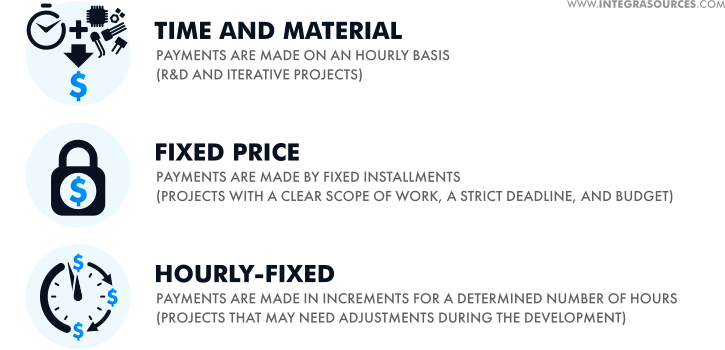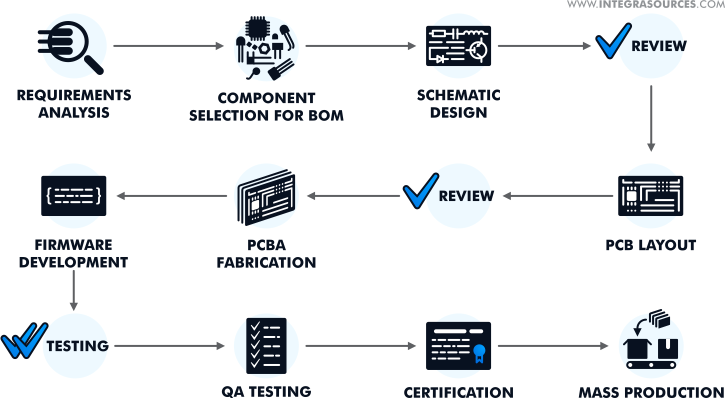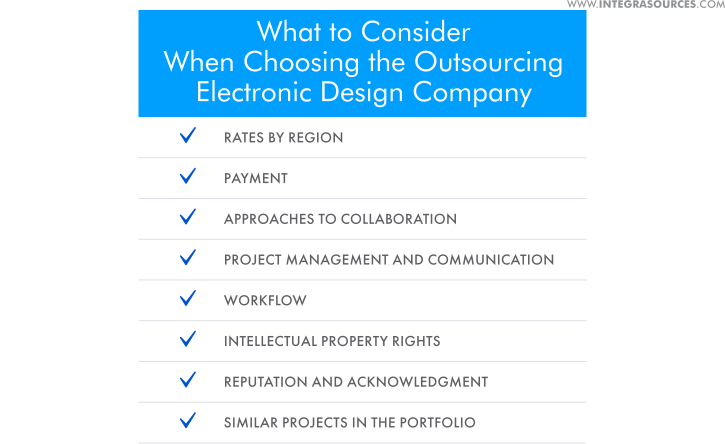This website uses cookies so that we can provide you with the best user experience possible. Cookie information is stored in your browser and performs functions such as recognising you when you return to our website and helping our team to understand which sections of the website you find most interesting and useful.
Guide to How to Choose the Right Outsourcing Electronic Design Company


Andrey Solovev
Chief Technology Officer, PhD in Physics and Mathematics

Anna Petrova
Writer With Expertise in Covering Electronics Design Topics
- Expertise and Capabilities of an Electronics Design Company
- What Else Is There to Consider When Choosing an Outsourcing Electronic Design Company?
- Rates by Regions
- Payment
- Approaches to Collaboration
- Project Management and Communication
- Workflow
- Intellectual Property Rights
- Reputation and Acknowledgment
- Similar Projects in the Portfolio
- Conclusion
There are plenty of convincing arguments for why outsourcing is beneficial. However, the key to success is the right choice of a remote team. Selecting a partner for electronic design services, you should consider a number of aspects. This article provides recommendations that can help you find the most suitable company to design your electronics.
- Expertise and Capabilities of an Electronics Design Company
- What Else Is There to Consider When Choosing an Outsourcing Electronic Design Company?
- Rates by Regions
- Payment
- Approaches to Collaboration
- Project Management and Communication
- Workflow
- Intellectual Property Rights
- Reputation and Acknowledgment
- Similar Projects in the Portfolio
- Conclusion
Outsourcing provides many opportunities for companies that lack their own resources or need specific knowledge. In our previous article, we have already talked about the compelling arguments for working with remote engineering companies and have given tips on how to find them.
Project owners are open to cooperation with contractors, yet it can cause a certain amount of anxiety. It's easy to understand the concerns you might have while entrusting the future of your device to people you don't really know. An external development team may reside in another part of the world, speak a different language, or have a different business style.
Distant cooperation may have certain nuances that you should consider well in advance. In our guide, we'll speak about the criteria that will assist you in selecting the right electronic design services company.
Expertise and Capabilities of an Electronics Design Company
Once you have thoroughly studied the information about the candidate on their website, professional network profile, and business platforms, you may proceed with an introductory call and then set up an interview with an engineering team.
From the very beginning, you should find out more about the expertise and technical capabilities of the company. Discussing your project, you may ask them about:
- Technology platforms. The choice of components may be different for one and the same project. Engineers may suggest various modules and chips, wired and wireless networks, etc. This will help you understand the level of technology awareness of the team. Besides, you can get a preliminary bill of materials (BOM) before starting a project. Your partner should keep track of the lifecycle of the main components to make sure they will not be discontinued and that you will be able to get the required chips or other parts of the device in the future.
- Computer-aided design (CAD) software. The PCB design and layout tools may include Altium Designer, EAGLE, Cadence Allegro, OrCAD, KiCad, or P-CAD. For FPGA design, hardware developers may also use Vivado and Quartus. We are familiar with all of the above-mentioned tools, but our PCB designers give preference to Altium. It provides a broad range of instruments and possibilities for creating boards of varying complexity.
- Equipment and instruments. Your project development may require different types of devices and tools, such as a laboratory power supply, multimeters, an oscilloscope, a signal generator, and a logic analyzer. You should make sure all the necessary equipment is available on the developer's side.
- Testing and validation. It is essential to know how your partner verifies their electronic design before and after production. Integra has a multistage testing process that includes several internal reviews of the schematics and PCB layout. In our validation process, we employ electrical rule checking (ERC), design rule checking (DRC), electronic circuit simulators, and test points. Manufactured boards are tested by our quality assurance (QA) engineer.
- Deliverables. Upon the completion of an electronics project, your partner should provide you with the necessary output files and deliverables, such as PCB and schematic design files, assembly drawings, Gerbers and other PCB production files, BOM, 3D models, and testing instructions.
- PCB manufacturing. Ask your potential contractor where they produce PCBs and how this process is handled. A development team should cooperate tightly with a factory and provide them with the required production files. Integra has long-term relationships with several manufacturers and we monitor the fabrication process very closely. If necessary, we develop testing firmware for automatic or semi-automatic PCBA testing at the factory.
What Else Is There to Consider When Choosing an Outsourcing Electronic Design Company?
There are other important aspects that you should bear in mind when considering a contractor. Below is a list of additional criteria that can help you make the right choice.
Rates by Regions
A developer’s hourly rate is one of the biggest concerns of a customer. First of all, it depends on the location of the company. The salary scale is determined by the national economy and living standards. It is obvious that the hourly rates of engineers from the US, Northern and Western Europe are higher than the rates of the same specialists from developing countries.
For example, according to Clutch, the top hardware development companies from Russia and Ukraine charge from $25 to $99 per hour, whilst the hourly rates of their competitors from the USA and the UK may vary from $50 to $300. That's why professionals from the Eastern European countries are in great demand.
You should keep in mind that rates vary according to the experience and skill level of the engineer engaged in your project. However, high rates don't always mean high quality. Thus, you can find a well-versed firmware engineer with a relatively low hourly rate. Or you can get overcharged by a poorly qualified developer.
So to get a good quality-to-price ratio, we recommend you monitor the rates and consider the other criteria from our list. They will also assist you in choosing the right electronics design company.
Payment
Payment terms differ depending on the type of cooperation, project requirements, and business processes of both the client and contractor.
Depending on the project type, you can make regular payments on an hourly basis or pay by fixed installments for each milestone.
An hourly-based or time-and-material model fits research and development (R&D) projects that need investigating. For example, you can use this approach when you are not sure about the choice of a technology or component for your electronics design and need to check it.
It is also suitable for the cases when the exact deliverables are hard to predict or when requirements may change throughout the development process. A time-and-material pricing model enables an engineer to work in iterations and it is well-suited for projects connected with constant polishing and long-term testing.
You can choose a fixed-price model if you have a clear scope of work with a strict deadline and budget. In a fixed-price contract, a development company includes all possible risks in the project assessment and takes full responsibility for meeting the estimation.
This is a good option for electronics design, especially when the developer has similar experience and case studies in the portfolio.
Integra Sources offers one more option - an hourly-fixed pricing model. In this case, we estimate the scope of work and specify the fixed upper range that we will not exceed. The client pays for a determined number of hours and we work them out till the next payment.
This model allows you to adjust the project when necessary. Unlike a fixed-priced contract, risks are not included in the estimation, and in a real-case scenario, the development can take less time and therefore cost less money.

Before entering into an agreement, you should discuss and specify the currency, order, and method of payment suitable for both parties. You can pay either in advance or after the job is completed with the help of a credit card, an online payment system, or a bank transfer.
If you are planning to cooperate via an intermediary platform, you should stick to the payment conditions and methods they offer.
Approaches to Collaboration
The right approach to cooperation can guarantee on-time and on-budget project delivery. Choosing an electronics design partner, learn about their models of collaboration.
There are two main development approaches - agile and waterfall. The first methodology offers flexible and incremental development. With the agile model, a customer can correct the specification as needed and a developer will tweak the project accordingly.
The waterfall approach provides rigid and sequential development. Here, you cannot start the next project phase unless the first one is completed and verified. This methodology can be a good fit for projects with well-defined specifications that need no adjustments.
Depending on your requirements, Integra can use either of these approaches. However, we tend to prefer the agile development model as it is a better way to meet customer expectations.
Outsourcing electronic design companies may have different collaboration frameworks. For example, if you need full-time project engagement and an opportunity to control the entire development process, you can choose a dedicated team.
If you have doubts about the feasibility of your project, you can start with a research and development model. To review your existing PCB design, you can use a consulting service.
Our team applies several delivery models:
- project-based outsourcing;
- dedicated development team;
- research and development;
- technology consulting.
Project Management and Communication
While interviewing a candidate, don't hesitate to ask questions: Who will be engaged in the development? Who is in charge of project management? Who is the primary contact point? How is communication held?
In well-structured companies, responsibilities are shared among the team members. For example, the Integra Sources core project team comprises:
- engineers;
- a technical lead;
- a project manager (PM);
- the chief technical officer (CTO);
- a business development manager (BDM);
- an account manager.
A BDM is the first contact point that provides all information about the company and helps you understand whether or not we are a good fit for each other. Once the contract is signed, an account manager picks up the baton and becomes a liaison between you and the internal team.
A tech lead is in charge of the technical management and deliverables. A PM ensures that the team delivers the project on time and within the budget.
Nota Bene. Fluent English is a must, not only for the salespeople but also for the technical team of the company. It will allow you to discuss the project in detail, either verbally or in text. All members of the Integra team have a good command of English and constantly improve this knowledge.
When doing business with an outsourcing team from another country or region, it is necessary to take note of the cultural differences and misunderstandings that may result from this diversity. Before engaging in cooperation, make sure you and your partner are on the same page about business ethics and the approach to collaboration.
Be sure to pay attention to the time zone of the outsourcing company. It is more convenient to cooperate with people whose working hours are in sync with your schedule. Integra Sources is in GMT+7; however, we work with clients all over the world, including the US, Canada, Europe, Asia, and Australia.
Our PMs can be available from 7 am to 11 pm our time, and we can always keep up with a customer, choosing a suitable time slot for an online discussion. In some cases, the time difference works in our partner's favor. By the end of our working day, we provide the results, and the client has a day ahead to check them and give feedback.
Project management tools and online meetings work best for outsourcing cooperation. They can help you keep track of the progress and get the latest updates. We use Basecamp, Jira, Slack, Redmine, Skype, Google Hangouts, and Zoom to stay in touch with the customer throughout the development and after the project's handover.

Workflow
The project implementation will be more efficient if the workflow is well-organized on both sides. You should be ready to allocate someone to manage the cooperation and coordinate actions between the internal and external teams.
For example, our electronics design workflow may include the following phases:

The picture above shows a simplified workflow for electronic design. After each subsequent stage, you may return to the previous phases if issues arise. For example, you might decide to go back to the schematic design, PCB layout, or component selection after the review or testing stages.
Your participation might be necessary in some phases. Thus, clearly defined requirements are important at the first stage. A detailed specification can help you stay within the budget and timeline.
The final document should include the core components and main functional requirements of your electronic device. If you have a clear picture of the mechanical design, the engineering team will need a 3D model of the enclosure. Or you can provide, at least, the desired PCB dimensions so that it could fit the size and shape of the housing.
Except for the device functionality, it is also important to know your business requirements and product idea. Knowing this, your partner can suggest the most suitable technology and approach to the design and implementation of the project.
Remember to keep your contractor updated if any changes occur. Unlike in software development, any modification made in electronics design is a much more complex and time-taking process.
The design of complicated electronic devices is normally a multi-stage process that may include several iterations of PCB layout, routing, and prototyping. It may happen because of the difference between documentation and real characteristics and behavior of the electronic components. After the first PCB review, hardware engineers make a decision on whether the second iteration is required.
The involvement of your internal experts is critical in reviewing intermediary results and testing final deliverables. If your electronic device is part of a bigger system, we might need the hardware of the connected equipment for full-scale testing. If your device has a complicated enclosure, we can also ask you to send us the mechanical part.
Signing a non-disclosure agreement (NDA) is a common practice if you work with an outsourcing company. This is the first step to build trust between you and the contractor. Apart from the NDA, we strongly recommend you sign a contract. With this, you can specify all cooperation details, including the deliverables you expect.
The paperwork may be time-taking, but it helps define the collaboration framework and responsibilities of the parties. In our contract form, we try to specify as many details as possible, including:
- rights and obligations of the parties;
- confidentiality of the information provided;
- estimation with a work breakdown structure;
- timeline and project schedule;
- payment terms;
- project deliverables;
- assumptions;
- development tools and environment;
- warranty and post-warranty support.
Intellectual Property Rights
One of the most important things that you should keep in mind while outsourcing your electronics design is the right to the intellectual property (IP) created in the course of the project development. To protect your ownership rights, you can take a variety of measures. Thus, to make yourself safe, you can:
- consult an IP lawyer;
- sign an NDA;
- sign a contract, or a master service agreement (MSA);
- specify the IP owner together with the list of the owned intellectual property and all the penalties involved in the contract;
- delegate tasks to different teams to protect the entire product design from copying or reverse engineering;
- patent your product, carefully studying the patent law in advance.
In our contract form, all the IP rights are transferred to the customer after full payment of the completed works. From this moment on, we can't lay any claims on the ownership of the project deliverables.
Reputation and Acknowledgment
One of the most reliable ways to find out the truth about your potential contractor is to check reviews left by their past and current customers. Their opinions can be subjective, but they still can give you a general impression of the people you are going to work with.
Clutch, GoodFirms, and similar services share ratings and reviews of the industry leaders. It is helpful to use such sources when choosing an electronics design company.

Freelancing platforms for remote collaboration, such as Upwork and Freelancer, also have rating systems for experts in different development areas. Besides, clients can provide feedback and give grades to the team they cooperated with.
You can also ask your contractor for references. If they are eager to share them, this is a positive sign for you.
A high level of service and customer satisfaction results in long-term relationships. A happy client will definitely come back to redesign and update their electronics or build a new device. Many of Integra's customers have already released several versions of their products developed by our team.
When discussing your project, pay attention to the questions candidates ask you. Engineers from the best electronic design companies will not only enquire about deep technical details but also suggest some approaches to solve potential problems.
If you are not sure that the outsourcing company is a good fit for you, it is better to start your cooperation with a small project or give them a test task. After the successful completion of the first stage, you may proceed with the development of a bigger and more complex project.
Similar Projects in the Portfolio
Relevant experience can speed up the development process and save your budget. It ensures the compliance of the project deliverables with your requirements and expectations. As you search for electronic design companies, be sure to look at their portfolio to see whether they have similar case studies.
Projects may require the development of both hardware and software. For example, to create a GPS tracking system, you would need schematics, PCB, firmware, backend and frontend for a cloud platform, and a mobile application. It is more convenient and efficient to have all parts of the project built in one place and by one team.
As a product development company, Integra Sources can complete a variety of tasks. For the custom IP camera, our embedded engineers built hardware and software for video streaming. For the smart home automation system, we designed electronics, created a custom Linux build, and wrote drivers.

Conclusion
The global outsourcing market offers a wide range of electronic design services. To hire the right people and make the best of this cooperation, you should consider several important aspects when you choose the outsourcing electronic design company. The selection criteria include, but are not limited to:
- technical capabilities and workflow;
- hourly rate;
- collaboration model;
- experience with similar projects;
- knowledge of English;
- reputation.
The use of the checklists provided in this guide and our related article can help you find the right fit to design your product. If you have any questions about outsourcing hardware and software development, you are welcome to contact us with your inquiries and ideas.
Share this article


Related
materials

5 Common US & EU Consumer Electronics Certifications in Infographics
Certifying a product requires time and money, which is why making a mistake here can lead manufacturers to serious financial...
LEARN MORE
LEARN MORE

Guide to Finding the Right Outsourcing Electronic Design Company
Choosing the right partner for electronic design services, you can achieve the desired results and complete your project within budget...
LEARN MORE
LEARN MORE


Variometer for Paraglider Pilots
The device indicates the climb/sink rate during paraglider pilots' flights. We provided PCB design for the variometer and ported firmware...
LEARN MORE
LEARN MORE


